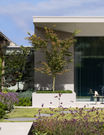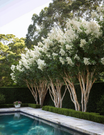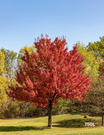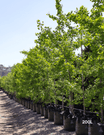When elevating your garden’s aesthetic, trees with unique and visually striking bark can serve as focal points and conversation starters. Not only do these trees add texture and visual interest, but they also play a crucial role in enhancing air quality. In this blog post, we’ll explore three exceptional trees: Betula pendula (Silver Birch), Eucalyptus cinerea (Silver Dollar Gum), and Lagerstroemia indica (Crape Myrtle). These trees bring charm and character to your outdoor space, making them valuable additions to any high-end garden.
Enhancing Your Garden’s Aesthetic
When planning your garden, consider the interplay of textures and colors. Trees with striking bark, such as Betula pendula, Eucalyptus cinerea, and Lagerstroemia indica, can serve as excellent backdrops for flowering plants and shrubs. Their unique features allow them to stand out even in the most vibrant landscapes. For instance, the white bark of the Silver Birch contrasts beautifully with colorful flowering plants. At the same time, the silvery leaves of the Silver Dollar Gum provide a soothing palette alongside darker foliage. Incorporating these trees into your design can create visual layers that captivate the eye and enhance the overall aesthetic of your outdoor space.
Betula pendula (Silver Birch)
The Silver Birch is celebrated for its distinctive white bark that peels in thin, papery layers. This feature adds elegance and creates a stunning contrast against lush greenery. Its delicate, airy canopy filters sunlight beautifully, making it a favorite among garden enthusiasts.
Key Facts
- Mature Height: 15–25 meters
- Mature Width: 8–12 meters
- Best Uses: Feature tree, natural screening
- Leaf Appearance: Triangular-shaped leaves that turn yellow in autumn
- Rate of Growth: Fast
- Tolerates: Poor soil conditions, drought

Why It’s Perfect to Add to Your Garden
The Silver Birch is an ideal choice for adding a touch of sophistication and texture to your garden. Its striking bark serves as an eye-catching element and creates a serene ambiance. Use it as a feature tree to draw attention to a specific area, or plant it in groups for a natural screening effect. Plus, this tree thrives with minimal maintenance, making it perfect for busy homeowners who still want to enjoy the beauty of nature.
Eucalyptus cinerea (Silver Dollar Gum)
The Silver Dollar Gum is renowned for its rounded, silvery-blue leaves and smooth, greyish bark that peels to reveal a striking new layer beneath. This visually appealing bark and foliage create a soothing color palette that complements any garden design.
Key Facts
- Mature Height: 8–12 meters
- Mature Width: 6–10 meters
- Best Uses: Feature tree, windbreak
- Leaf Appearance: Round, silvery-blue leaves
- Rate of Growth: Moderate to fast
- Tolerates: Drought, poor soil

Why It’s Perfect to Add to Your Garden
The Eucalyptus cinerea (Silver Dollar Gum) is a stunning and functional addition. Its unique bark and foliage provide texture and contrast, making it perfect for creating visual interest in your landscape. This tree can also act as a beautiful windbreak, helping to protect other plants in your garden. Its moderate to fast growth rate and resilience make it an excellent choice for homeowners looking for a tree that requires minimal upkeep while still making a strong impact.
Lagerstroemia indica (Crape Myrtle)
The Crape Myrtle is famed for its stunning bark, which peels away to reveal smooth, cinnamon-colored layers. This tree stands out for its unique bark and boasts vibrant summer flowers, making it a year-round beauty in any garden.
Key Facts
- Mature Height: 3–6 meters
- Mature Width: 3–5 meters
- Best Uses: Feature tree, ornamental focal point
- Leaf Appearance: Dark green leaves that turn vibrant shades in autumn
- Rate of Growth: Moderate
- Tolerates: Heat, humidity, and drought
Why It’s Perfect to Add to Your Garden
With its captivating bark and colorful blooms, the Lagerstroemia indica (Crape Myrtle) offers exceptional visual appeal and seasonal interest. It serves as an ornamental focal point that can brighten up any space. The tree's peeling bark adds a layer of texture that contrasts beautifully with its lush foliage. Additionally, its ability to thrive in various conditions makes it an excellent option for discerning homeowners looking to enhance their gardens with minimal effort.
Creating a Harmonious Environment
In addition to their beauty, these trees play a vital role in creating a harmonious garden environment. By improving air quality and providing shade, they contribute to a more enjoyable outdoor experience. As you spend time in your garden, the presence of trees like the Crape Myrtle adds comfort and promotes biodiversity by attracting birds and beneficial insects. Choosing the right trees can transform your garden into a serene retreat where the natural beauty of the landscape complements the elegance of your home. By investing in these striking species, you’re enhancing your property and nurturing the environment, positively impacting future generations.
Conclusion
Incorporating trees with striking bark like Betula pendula, Eucalyptus cinerea (Silver Dollar Gum), and Lagerstroemia indica into your garden enhances its aesthetic appeal and improves local air quality. These trees filter air pollutants, providing a healthier environment for you and your family. Each tree offers unique characteristics that can elevate your outdoor space, making them smart choices for any high-end garden. Whether you’re looking for a stunning focal point or a practical solution for screening, these trees are sure to impress.
FAQs
-
What is the best time to plant these trees?
Spring or autumn is ideal, allowing trees to establish their roots before extreme weather. -
How often should I water these trees?
Water newly planted trees deeply once a week for the first few months, then adjust based on rainfall. -
Do these trees require a lot of maintenance?
No, all three trees are relatively low maintenance, making them perfect for busy homeowners. -
Can I plant these trees in small gardens?
Yes, they can be suited for small spaces if selected and placed thoughtfully, especially varieties like Lagerstroemia indica (Crape Myrtle). -
How do these trees help improve air quality?
They absorb carbon dioxide and filter out pollutants, improving the air quality around your home.

































Leave a comment
This site is protected by hCaptcha and the hCaptcha Privacy Policy and Terms of Service apply.